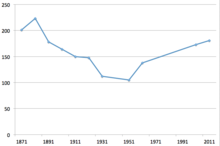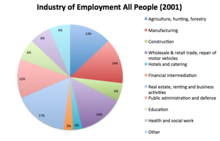Buckworth
| Buckworth | ||
|---|---|---|
Shire county | ||
| Region | ||
| Country | England | |
| Sovereign state | United Kingdom | |
| Post town | Huntingdon | |
| Postcode district | PE28 | |
| Dialling code | 01480 | |
| Police | Cambridgeshire | |
| Fire | Cambridgeshire | |
| Ambulance | East of England | |
| UK Parliament | ||
Buckworth is a village and
The village is located on the slope of a hill, in the middle of farmlands and facing northeast. The road crossing Buckworth (Church Road) joins Alconbury and Barham and is the main street of the village.[4]
History
Middle Ages
According to the Dictionary of British place-names, the name of the parish comes from the "enclosure of a man called Bucc, or where bucks are kept".[5][6]
In 1085, William the Conqueror ordered that a survey should be carried out across his kingdom to discover who owned which parts and what it was worth. The survey took place in 1086 and the results were recorded in what, since the 12th century, has become known as the Domesday Book. Starting with the king himself, for each landholder within a county there is a list of their estates or manors; and, for each manor, there is a summary of the resources of the manor, the amount of annual rent that was collected by the lord of the manor both in 1066 and in 1086, together with the taxable value.[7]
Buckworth was listed in the Domesday Book in the Hundred of Leightonstone in Huntingdonshire; the name of the settlement was written as Buchesworde in the Domesday Book.[8] In 1086 there was just one manor at Buckworth; the annual rent paid to the lord of the manor in 1066 had been £10 and the rent had increased to £13 in 1086.[9]
The Domesday Book does not explicitly detail the population of a place but it records that there was 25 households at Buckworth.[9] There is no consensus about the average size of a household at that time; estimates range from 3.5 to 5.0 people per household.[10] Using these figures then an estimate of the population of Buckworth in 1086 is that it was within the range of 87 and 125 people.
The Domesday Book uses a number of units of measure for areas of land that are now unfamiliar terms, such as
The tax assessment in the Domesday Book was known as
By 1086, there was already a church and a priest at Buckworth. In 1066, the Lord was Earl Tosti and in 1086 Robert Count of Eu. The Head of the Manor is mentioned to be Great Paxton I. Concerning agriculture, Buckworth used to be on the route from the north of England to bring animals to the
The 19th Century
From 1 July 1837, Buckworth was a part of the Huntingdon Registration district. Thereafter, it was integrated to the Spaldwick sub-District. However, it is now back in the Huntingdon District.[12] Buckworth was a part of the Poor Laws in the Huntingdon Union.[13][14]

In the 1870s, Buckworth was described as:" BUCKWORTH, a parish in the district and county of Huntingdon; 5¼ miles W of the Great Northern railway, and 7 NW of Huntingdon. Post Town, Alconbury, under Huntingdon. Pop., 201. Houses, 39."[15]

The first Census available for Buckworth is dated at 1801 and at this time the village was composed of 130 inhabitants only. The population had grown consistently until 1880. In the 1881 Census of population, the number of people living in Buckworth was 223, which was the highest so far. Until 1950 the population decreased more or less constantly and the population's growth began again at the beginning of the 1950s up to now.[15]
As reported in the 1831 and 1881 Occupational Orders, the main source of employment for men was agriculture. In 1881, female workers were employed in
First and second World Wars
According to a
Present Day

According to the
Buckworth had a population of 181 according to the 2011 census.
Government
As a civil parish, Buckworth has a
Buckworth was in the historic and administrative county of Huntingdonshire until 1965. From 1965, the village was part of the new administrative county of Huntingdon and Peterborough. Then in 1974, following the Local Government Act 1972, Buckworth became a part of the county of Cambridgeshire.
The second tier of local government is
For Buckworth the highest tier of local government is
At Westminster, Buckworth is in the parliamentary constituency of
Places of interest

- All Saints church, the main building and the landmark of the parish stands at its centre.graveyard.[40]
- Buckworth Cricket Club, founded in 1958, is situated in Church Road. When the local Parish Council or different events. It is at the centre of the village and is used for many purposes, such as a polling station.[41]
- Buckworth School was built in 1870 and was composed of an infant school and a sunday school. It was closed in the late 1950s.[42] It is now used as a private residence.[43]
- The Old Rectory was built in the 1670s. It was the home of vicars up to 1951 and was then sold by Church Commissioners.[44]
- Buckworth Manor, known as The Old Manor House, is a Victorian house, probably built in the 1860s.[45]
- The farms: Home Farm, Manor Farm, Holly Lodge Farm, Brickyard Farm and Park Farm are the five farms situated in the parish.[46][4]
- Buckworth Wood is located in the west of the parish and is surrounded by farmlands.[47]
References
- ISBN 9780319229248.
- ^ "History of Buckworth". Buckworth Council. Archived from the original on 6 September 2013. Retrieved 27 March 2014.
- ^ "Huntingdonshire Hundreds". Cambridgeshire History. Retrieved 27 February 2014.
- ^ a b William Page, Granville Proby and S. Inskip Ladds (editors) (1936). "Parishes: Buckworth". A History of the County of Huntingdon: Volume 3. Institute of Historical Research. Retrieved 6 March 2014.
{{cite web}}:|author=has generic name (help) - ^ "Buckworth". Key to English place names. Retrieved 26 February 2014.
- ISBN 9780199609086. Retrieved 20 February 2014.
- ISBN 0-141-00523-8.
- ISBN 0-141-00523-8.
- ^ a b c d e Professor J.J.N. Palmer, University of Hull. "Open Domesday: Place - Buckworth". www.opendomesday.org. Anna Powell-Smith. Retrieved 25 February 2016.
- ^ Goose, Nigel; Hinde, Andrew. "Estimating Local Population Sizes" (PDF). Retrieved 23 February 2016.
- ^ Brown, Christine. The Buckworth Experience (PDF). p. 23. Archived from the original (PDF) on 6 March 2014. Retrieved 27 March 2014.
- ^ Hinson, Colin. "Buckworth - Civil Registration". Genuki. Retrieved 27 February 2014.
- ^ "Poorhouses and Poor Law Etc". Genuki. Retrieved 27 February 2014.
- ^ "Poor Laws Union". Cambridgeshire History. Retrieved 27 February 2014.
- ^ a b Wilson, John Marius (1870–1872). Gazetteer of England and Wales (1st ed.). Edinburgh: A. Fullarton & Co. Retrieved 5 February 2014.
- ^ Wilson, John Marius (1870–1872). Gazetteer of England and Wales (1st ed.). Edinburgh: A. Fullarton & Co. Retrieved 5 March 2014.
- ^ Brown, Christine. The Buckworth Experience (PDF). p. 34. Archived from the original (PDF) on 6 March 2014. Retrieved 6 March 2014.
- ^ Brown, Christine. The Buckworth Experience (PDF). p. 24. Archived from the original (PDF) on 6 March 2014. Retrieved 27 March 2014.
- ^ Brown, Christine. The Buckworth Experience (PDF). p. 24. Archived from the original (PDF) on 6 March 2014. Retrieved 25 March 2014.
- ^ "Industry of Employment - All People, 2001". Neighbourhood Statistics. Retrieved 26 February 2014.
- ^ "Buckworth - Key Statistics". Neighbourhood Statistics. Retrieved 22 April 2014.
- ^ a b "Church Road, Buckworth". British streets. Retrieved 3 March 2014.
- ^ "Area stats - Property value data". Zoopla. Retrieved 6 March 2014.
- ^ "Area stats - Sold house prices in the last 12 months". Zoopla. Retrieved 6 March 2014.
- ^ "Huntingdonshire District Council: Councillors". www.huntingdonshire.gov.uk. Huntingdonshire District Council. Retrieved 14 February 2016.
- ^ "Huntingdonshire District Council". www.huntingdonshire.gov.uk. Huntingdonshire District Council. Retrieved 14 February 2016.
- ^ a b c "Ordnance Survey Election Maps". www.ordnancesurvey.co.uk. Ordnance Survey. Archived from the original on 20 February 2016. Retrieved 4 February 2016.
- ^ "Huntingdonshire District Council: Councillors". www.huntsdc.gov.uk. Huntingdonshire District Council. Retrieved 4 February 2016.
- ^ "Cambridgeshire County Council". www.cambridgeshire.gov.uk. Cambridgeshire County Council. Retrieved 15 February 2016.
- ^ "Cambridgeshire County Council: Councillors". www.cambridgeshire.gov.uk. Cambridgeshire County Council. Archived from the original on 22 February 2016. Retrieved 15 February 2016.
- ^ "Cambridgeshire County Council: Councillors". www.cambridgeshire.gov.uk. Cambridgeshire County Council. Archived from the original (pdf) on 5 February 2016. Retrieved 4 February 2016.
- ^ Argall, Ian. "Buckworth". Genuki. Retrieved 20 February 2014.
- ^ "All Saints, Buckworth". A Church of England. Archived from the original on 24 February 2014. Retrieved 20 February 2014.
- ^ "All Saint, Buckworth". British Listed Buildings. Retrieved 27 February 2014.
- ^ Hinson, Colin. "Buckworth". Genuki. Retrieved 25 February 2014.
- ^ Hinson, Colin. "Buckworth". Genuki. Retrieved 27 February 2014.
- ^ "Buckworth". British History Online. Retrieved 20 February 2014.
- ^ Dickens, Andrew. "Churches given £600,000 lottery cash for repairs". Cambridge News. Archived from the original on 6 March 2014. Retrieved 5 March 2014.
- ^ Ensor, Josie. "Resting place of Elizabeth I's 'lover' to be repaired with lottery funding". The Daily Telegraph. Retrieved 6 March 2014.
- ^ Trolove, Michael. "Buckworth graveyard". Wikimedia Commons. Retrieved 6 March 2014.
- ^ "About the Clubhouse". Buckworth Cricket Club. Retrieved 27 February 2014.
- ^ Brown, Christine. The Buckworth Experience (PDF). p. 14. Archived from the original (PDF) on 6 March 2014. Retrieved 6 March 2014.
- ^ Brown, Christine. The Buckworth Experience (PDF). p. 54. Archived from the original (PDF) on 6 March 2014. Retrieved 25 March 2014.
- ^ Brown, Christine. The Buckworth Experience (PDF). p. 55. Archived from the original (PDF) on 6 March 2014. Retrieved 27 March 2014.
- ^ Barnett, James. "Old Manor House". Savills. Retrieved 27 March 2014.
- ^ Brown, Christine. The Buckworth Experience (PDF). p. 26. Archived from the original (PDF) on 6 March 2014. Retrieved 6 March 2014.
- ^ "Buckworth Wood, Cambridgeshire". Explore Britain. Retrieved 27 March 2014.
External links
![]() Media related to Buckworth at Wikimedia Commons
Media related to Buckworth at Wikimedia Commons
